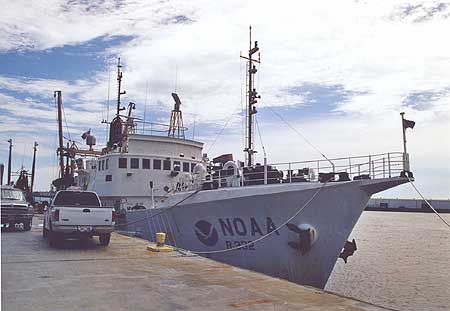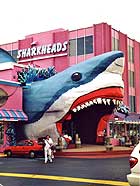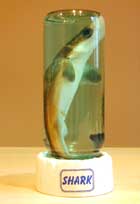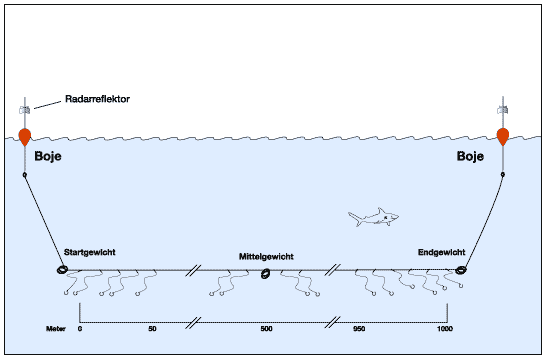|
By Dr. A. J. Godknecht, Dr. G. D. Guex
In 1993 a Fish Management Plan was put into force by the U.S. for
its coastal waters and since then the American government has been
monitoring results with annual investigations. Part of the plan also
includes analyzing the species composition and frequency of shark
populations (also see the report on this subject in
Shark Info 4/99). Entrusted with this work is the NOAA (National Oceanic and
Atmospheric Administration), i.e. its fishery department the NMFS
(National Marine Fisheries Service). Managing the program for the
Gulf of Mexico and the western North Atlantic is the fishery
biologist, Mark Grace, from the NMFS Laboratories in Pascagoula,
Mississippi.

|
The Oregon II, a former fishing vessel,
is one of the research vessels of NOAA.
© A. Godknecht / Shark Foundation
|
|
This research in the Gulf of Mexico takes place each year between
July and October and the Oregon II, an NOAA research ship, is
normally used for this purpose. The sharks are caught using a
longline (see below) in order to allow comparisons with commercial
fishery. This longline is left in the water for maximum one hour to
ensure that as many sharks as possible can be caught, measured,
tagged and released alive.
Catching and measuring sharks over a 24-hour period is
time-consuming work which cannot be performed by the sailors on
board the Oregon II. Mark Grace thus invites scientists and students
to participate and energetically help in this project in return for
board and lodging. Such volunteer work not only saves project money,
it is a fascinating experience for helpers, often representing their
first direct contact with sharks.
In August Dr. Gaston D. Guex and I had the opportunity to do
precisely such scientific volunteer work on board the Oregon II and
thus to gain firsthand project experience. Read about our trip
– in diary form – below and in the next issue of Shark
Info.
We depart with Swiss 064 from Zurich to Miami and then board a
connecting American Airlines flight to New Orleans, arriving at 10
p.m. The air is humid and the hotel’s air conditioning is
running at full blast. Too hot and too cold: Welcome to the tropical
zone.
Bourbon Street in the evening. A young taxi driver with a broad,
initially difficult to understand Louisiana accent, drives us
around. We get into a conversation. New Orleans obviously has some
dark corners which we are warned about, for widespread unemployment
has led to an especially high crime rate. Bourbon Street itself is
somewhat disappointing, more or less resembling other “red
light districts”. Only one single bar has an authentic
Dixieland band; with blacks in tuxedos, all over 50 and full of
swing. Dinner consisted of a fish platter with “stuffed
crabs”, a kind of pastry resembling a crab and filled with
crab meat which compared to pure crab meat was rather tasteless and
heavy. Oh well, at least the fish is excellent. At 2 a.m. we return
to the hotel and literally fall into bed half dead.

|
A shark greeting….
© A. Godknecht / Shark Foundation
|
|
8.50 a.m.: We just had breakfast and the temperature is already up
to 30 degrees with about 80 percent humidity. Is this a foretaste of
what we can expect on the Oregon II?
Sightseeing in New Orleans would be nice, but we have to leave. We
take Interstate 10 heading east to Pascagoula, Mississippi. The
night before we briefly telephoned with Mark and, considering that
it is high season for shrimps and crabs, he advised us to take
Highway 90 after Bay Saint Louis and drive along the coast via
Biloxy and Ocean Springs. He felt we would certainly find an
appropriate fish restaurant along the way. So off we went along the
very picturesque coast. Nice but very touristy, and it seemed as
though each town had at least two gambling casinos.

|
George W: Embryo of a sharpnosed shark as
a macabre tourist attraction.
© A. Godknecht / Shark Foundation
|
|
Having come directly from “sharkless” Switzerland, we
are quite amazed at some of the restaurant and shop facades.
Apparently sharks belong to daily life here. Tons of shark trophies
are found in souvenir shops; jaws, teeth, but the ultimate –
pretty macabre – hit are the bottled embryos of the Atlantic
sharpnose shark (Rhizoprionodon terranovae) in alcohol. After
mulling it over a long time, we finally decide to buy one –
for the shark exhibition – and name him George W.
Shortly after passing Biloxy – it had in the meantime begun to
pour – we found a nice restaurant which served us the promised
shrimp and crabs. After the meal not only the crabs were
„stuffed“, so we decided to take a short walk by the
sea. There we came across “back-to-back” fishermen,
despite the now light rainfall. Obviously we looked over their
shoulders, as proper tourists do, and instead of the rudd or perch
which we would have found in Switzerland, their catch consisted of
sharpnosed sharks. “Dogfish” said one of the fishers in
a rather disdainful way. As Mark told us later on, here all sharks
are called “dogfish”.
We reached Pascagoula later that afternoon. In our search for the
NOAA/NMFS laboratory a large blue van with four young ladies
suddenly pulled up alongside of us. “You’re looking for
the O2? Are you the guys from far away?”, it echoed from the blue
van. Somewhat perplex we affirmed both questions and the four
grinning ladies told us to follow them. Two minutes later we were
standing right in front of the Oregon II which was to be our
swimming home for the next 15 days.
Paul – the cook, as it quickly became obvious – took us
under his wings. He showed us our quarters and, with pride, the
galley’s bulging storerooms. Bye bye diet - we certainly
won’t have to starve. Since alcohol is prohibited on board, my
wife, Sabine, was hoping that without a glass of wine I would surely
lose some kilos over the 15 days.
After seeing our cabin, we decided to spend the last night ashore in
a hotel, after all, one doesn’t have to overdue it right from
the start.
In the morning we made our last purchases and then met Mark.
It’s always a strange feeling to suddenly stand face-to-face
with someone you have been E-mailing for several years. Mark greets
us warmly and turns out to be a tall, southern, quiet but extremely
humorous man. In his mid-40’s (like us), he doesn’t look
his age at all.
We are given a tour of the NMFS Pascagoula Laboratory. However, the
main activity in the morning – and Mark was clearly
embarrassed by this – was the taking of our fingerprints for
security purposes. We thus drove to the quiet police station which
proved to be rather overproportioned from the inside. A friendly
blond “Valkyrie” led us to an examination room which
smelled of antiseptics. There she quickly and painlessly took our
fingerprints, something she obviously was not doing for the first
time. We, however, found ourselves somewhat irritated by a plastic
chair with many buckles on it which we saw in the corner of the
room. It reminded us of a requisite from the movie “Silence of
the Lambs”. “It’s to keep people from
moving”, said the blonde, who did not fail to notice our
glances. Although the people had been nice, we were still relieved
to get outside where we tried hard to suppress thoughts on the
winding paths our fingerprints would take within obscure American
bureaucracy.
Back on the Oregon we learned that we could not depart at 1 p.m. as
planned. The compressor for the cold room needed to store the fish
bait was broken so we had to wait for a mysterious replacement part
which was under way from the North via Fedex and was expected to
arrive towards 5 p.m. Mark mumbled something to the effect that
“it could take longer, for the last time we had to wait three
days for a replacement part” and then disappeared in the
direction of the laboratory building.
Since we had nothing better to do we moved into our cabins,
obviously not without accumulating some black and blue marks, but we
would learn to adjust to the compact construction. Around 4 p.m. the
news broke that the replacement part was unfortunately under way
somewhere between “the North” and Pascagoula, and that
we would get more details tomorrow. In addition, we were told that
dinner would now be served on board between five and six p.m. Our
inner clock was, however, still ticking somewhere between
Switzerland and the U.S. so that “dinner between five and
six” appeared to be a little too early. We thus asked Paul
where we could get a typical Mississippi dinner in Pascagoula.
“Go the Tiki, it’s only about ten miles from
here”. Great, we had just returned our rental car. “No
problem” said Paul, “take the van”. And so, we the
freshly fingerprinted foreigners from “a far away
country”, wound up driving in an American government van to
have dinner in the Tiki. If only George W. – no, not our
conserved shark – knew.
The long awaited replacement part arrived sometime in the morning
and around one p.m. things began to roll. We switched to ship time,
i.e. from American a.m. and p.m. time, to our familiar 24-hour clock
system. We will be working through in two 24-hour shifts. Mark
recommended that we take the night shift from 0:00 until 12 noon
because it would not be so hot for Europeans unaccustomed to warm
temperatures. Ok, Mark lives here and also has enough experience, so
he must know what he’s talking about. Besides he will also be
working the night shift.
Meantime, we were also introduced to the remaining crew members and
the scientific team. Joining us in the night shift would be Melissa
who is in search of the yellowfin grouper for her thesis, and Jill,
whose main job is teaching during the semesters.
Dr. John Carlson, shark scientist from the NOAA Research Laboratory
in Panama City, Florida, was on the Oregon many previous times and
heads the day shift. His team consists of the young ladies from the
van, three students and Lenora who was hired for this trip by the
NMFS.

|
The Oregon II’s longline has exactly
100 hooks per one kilometer of line. During our trip the Oregon II fished only
with a bottom longline.
© Shark Info
|
|
Several miles off the coast of Pascagoula the day shift set the
first longline, a procedure we will probably never forget: First,
exactly 100 hooks are baited with mackerel. Then the Oregon slows
down its speed to about two knots. At the ship’s stern the
longline is attached to a buoy with radar reflector which is then
dropped into the water. The Oregon now moves away from the buoy and
slowly rolls out the longline. First, the starting weight is hung
unto the longline which pulls it down to the seabed. Every 10 meters
the baited hooks are then latched onto the longline, followed by a
middle weight after about 500 meters or 50 hooks. After exactly one
kilometer the end weight and finally the second buoy are attached to
the longline, marking its end. The line is then left in the water
for precisely 60 minutes.
Once fastened, we move to the bow of the ship and the CTD (see box),
a measuring instrument which records various chemical water
parameters, is slowly lowered into the water towards the seafloor
and then pulled up again. All in all CTD measurements take about 20
minutes and then it means waiting until the longline is pulled back
in. To do this the Oregon makes a slow, large circle back to the
starting buoy because experience has shown that it is easier to pull
back the line from the starting point.
Retracting the longline is especially exciting for all participants,
even the toughened crew. We managed to make ourselves comfortable
and picked the best vantage point to observe the work of the day
shift. First the buoy is pulled on board and the longline is
fastened to the capstan. Then it is pulled in at a virtually brutal
speed. We talked often and long with Mark on this high retraction
speed. In this case it is important to “process” the
sharks quickly. The faster they are returned to the water, the
higher their chances of survival, Mark says. We are rather
sceptical. Even though sharks have no air bladder, we feel that the
quick loss of pressure when pulling them out of the water is not
exactly healthy.
As soon as the starting weight is hauled on board the excitement
starts. A small Atlantic sharpnose shark is already hanging on one
of the first hooks, spinning around the line as it is pulled on
board. On the foredeck everything is ready to measure and tag the
shark. Speed is vital. John Carlson grabs the little rascal, a male,
as it fights wildly for its life, and with a skillful turn pulls the
hook out of the shark’s jaw.
The shark is then laid on a surveyor’s pole where its total
length, as well as the distance between the snout and the point at
which the upper and lower half of the tail fin meet (fork length) is
measured.
The shark is weighed and returned to the water as soon as all data
has been properly recorded. Mark joined us and said they already
tagged a sufficient number of sharpnoses so that the rest would only
be measured. After several sharpnoses, which the girls measured, a
smooth dogfish/dusky smooth hound (Mustelus canis) surfaces. He
looks to be about 1.20 meters longer than the previously measured 80
cm long sharpnose sharks. The dogfish is measured, tagged and also
receives an injection with OTC (oxytetracycline). OTC is deposited
in the spinal cord like an annual ring. If the shark is caught again
at some point later on, its growth rate can be calculated based on
the growth of the spinal cord since the injection.
|
At each station where the longline is set, the water is analyzed
with a “CTD” instrument which stands for Conductivity,
Temperature and Depth. This apparatus can also determine oxygen
content and plankton concentration. A chemical water profile is thus
made as the CTD is lowered to the seafloor.
The Oregon itself is equipped with sensors located at more than 20
points between the mast and the keel. These deliver data to the
central computer during the entire journey. In this way permanent
data on water temperature (surface/keel), air humidity, temperature,
wind force and many other items are registered and then forwarded to
the NOAA’s oceanographic department for evaluation.
|
More sharpnoses are pulled on board, all males and all about the
same size. We have obviously caught a male swarm. Sharpnoses are
known for swimming in segregated schools of the same sex. Some of
them could only be salvaged in the form of heads or remaining front
body parts, apparently having been snatched by other sharks.
Some spinner sharks (Carcharhinus brevipinna) – small
specimens about 1.3 meters long – are now coming up between
the sharpnoses. They are easily distinguishable from blacktip sharks
(Carcharhinus limbatus) by their black anal fins. They are measured,
tagged and released.
Suddenly there is much excitement among the day-shift personnel. A
2.50 meter long blacktip shark is pulling on the line and in his
struggle has tangled a row of hooks into a big mess. He’s
hanging on the hook together with the head of a sharpnose shark
which he apparently wanted to eat. He is too large to be pulled on
board. John tries to pull him out of the water a bit in order to
determine the sex. He is obviously a male because of his claspers.
His entire length is estimated. Weight and fork length will be
determined later on based on tables. The shark is now tagged, a
ticklish job considering that he is swimming back and forth on the
hook and is trying to submerge. The tag is attached to a 2.50 meter
long pole and and in bending overboard John tries to attach it
directly below the shark’s dorsal fin into his fin rays where
it will bother him the least. John’s first attempt is
successful thanks to his high experience. “Good shot” is
heard from the right and approval from the left. The hook is then
simply cut off and the shark takes off like a flash. I asked if the
hook didn’t bother the shark and John replied, the hook
“will rust itself out of the shark’s body” (see
the report on “pathological changes caused by hooks in blue
sharks” in this issue of Shark Info).
Several more sharpnoses are pulled on board followed by the end
weight. It was extremely exciting. It is now about 2 p.m. Our shift
starts around midnight and we can hardly wait.
(To be continued in the next issue of Shark Info.)
* Dr. Alexander J.
Godknecht and Dr. Gaston D. Guex are biologists and members of the Shark
Foundation Board of Directors and the editorial team of Shark Info.
May be published only by indicating the source: Shark Info / Dr. A. J. Godknecht, Dr. G. D. Guex
|




